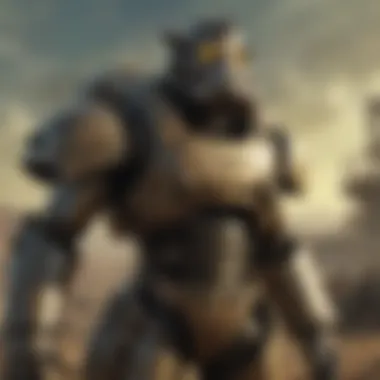Exploring Modern Paintings: Key Movements and Artists


Intro
Modern paintings have become a specific area of study and appreciation in the world of art. By exploring the evolution and the key movements that shaped these works, one can gain valuable inight into how art reflects societal changes. This analysis will address different styles, techniques, and historical contexts that contribute to the discourse surrounding modern art. We will also consider significant artists who have forged their path and altered the landscape of contemporary artistic practices.
Understanding modern paintings involves more than just appreciation. It allows us to connect the dots between various art movements and the cultural narratives they represent. This exploration invites readers to ponder the thematic undertones and societal reflections embedded within the artworks. Ultimately, modern paintings serve not only as expressive avenues but also as historical commentaries that continue to influence the present.
Lore Insights
Overview of Modern Art
Modern art refers to a wide array of artistic movements that emerged from the late 19th century to the mid-20th century. This period marks a shift in how art was made, valued, and interpreted. Artists began to break free from traditional techniques and constraints, embarking on a quest for nouveaus forms and expressions.
Key Historical Events in Modern Art
- The Impressionist Movement (1870s): This marked a decisive break from the past. Impressionists like Claude Monet challenged established rules of painting. Their focus on capturing light and everyday life created a stir in the art world.
- Post-Impressionism (1880s): Continuing from Impressionism, figures like Vincent van Gogh explored personal emotion, leading to the rise of abstract art. They played a essential role in setting the foundations for future movements.
- Cubism (Early 1900s): Pioneered by Pablo Picasso and Georges Braque, Cubism transformed traditional perspectives and spatial representations. It highlighted the essence of the subject through fragmented forms.
- Surrealism (1920s): This movement explored the unconscious mind, employing dream-like scenes and bizarre imagery. Artists like Salvador Dalí pushed boundaries regarding how art relates to the human psyche.
These events and others form an important tapestry of artistic practice and conceptual thought, serving as links in the chain that leads to contemporary art.
Closure
The exploration of modern paintings opens a fruitful discussion on how history intertwined with creative expression challenges beliefs and norms. When responding to the aesthetics of the modern age, one uncovers deeper meanings that resonate with everyday experiences. Effective engagement with modern art proposes a rich area of scholarship and appreciation that fosters ongoing dialogue in the broader context of societal evolution.
Intro to Modern Paintings
Modern paintings represent a pivotal transformation in the art world, where the boundaries of creativity have expanded significantly. This section aims to introduce readers to the vital themes and shifts that characterize the modern art movement, emphasizing why modern paintings matter today. Unlike traditional paintings that often focused on realism and historical subjects, modern paintings challenge observers to interpret unique expressions and emotional depth, reflecting the complexity of contemporary society.
One essential element when exploring modern paintings is the notion of subjectivity. Individual interpretation plays a key role, influencing how one perceives strokes, colors, and forms. Viewers frequently encounter artwork that encourages emotional responses over mere aesthetic admiration. Thus, understanding modern paintings requires an awareness of diverse artistic intentions. This notion breaks away from conventional art, promoting individuality instead of adherence to standardized techniques.
Additionally, modern paintings act as a reflection of their cultural and historical contexts. The socio-political upheavals throughout the late 19th and early 20th centuries significantly influenced artists to create responses to their experiences. They often sought to help others see their reality or transformation in exciting new ways. Therefore, examining modern paintings often intertwines with considering the historical moments they encapsulate. This highlights not only historical significance but also how relevant art can be to societal changes. Art is a vital archive of human emotion and change.
The benefits of delving into modern paintings are manifold. First, they promote critical discussion about how observation, context, and individual experiences feed into our understanding of all artwork. Further, they enable us to explore the complexity of artistic expression, enriching our appreciation of training in contemporary themes and abstract ideas. Serounsly engaging with modern art encourages broader thinking about both the well-known painters and their movements.
The Historical Context of Modern Art
Understanding the historical context of modern art is essential in grasping its evolution and significance. Modern art challenges traditional aesthetics, societal norms, and historical narratives. This section uncovers how radical shifts in art reflect broader changes in culture, politics, and philosophy since the late 19th century. By analyzing the factors leading to this transformation, we can better appreciate modern paintings not just as artistic expressions but as documents of their time.
The Transition from Traditional to Modern
The transition from traditional to modern art represents a profound shift in artistic approach and rationale. This period marks a clear move away from the norms of classical representation. Artists began to explore new subject matter, techniques, and philosophies.
As academic rules dictated the artistic landscape, figures such as Edgar Degas and Claude Monet emerged, turning away from detailed realism and towards capturing fleeting moments. Impressionism was among the first available movements to push back against rigidity. Instead of focusing solely on realistic representation, artists employed loose brushwork and concentrated on light effects. Their portrayals created a different reality, emphasizing emotion over precision.
Subsequently, movements like Cubism and Dada challenged the essence of perspective and traditional form. Pablo Picasso, one of its key proponents, advocated viewing objects from multiple angles in his artworks. This radical approach triggered further inquiries into abstraction. Therefore, understanding the shift allows deeper insight into later avant-garde movements.
Socio-Political Influences


The evolution of modern art did not exist in a vacuum. Socio-political factors heavily shaped this artistic landscape. Major events, including world wars, the Great Depression, and social movements, influenced how artists responded to their circumstances. During periods of turmoil, artists sought to redefine purpose through their works.
For example, the impact of World War I inspired artists to create art that reflected human suffering and disillusionment. The Dada movement rose from this chaos, showcasing disdain for conventional logic. Artists like Marcel Duchamp forced audiences to reconsider what art means.
Around the same time, the rise of political movements demanded focus on societal issues, effectively shifting the subject matter in art. Artists like Diego Rivera used their work to depict social inequities, aiming to provoke thought and inspire action.
In summary, the interplay of societal events with artistic practice illustrates how modern paintings engage with history, thus holds a mirror to changing times.
“Art is the most beautiful of all lies.” – Pablo Picasso
Defining Characteristics of Modern Paintings
Understanding the defining characteristics of modern paintings is essential for deciphering the evolution and variety present in contemporary artistic expression. This section will discuss crucial elements that differentiate modern art from prior movements, focusing on how they reflect the complexities of the human experience, as well as the social, political, and technological contexts of their creation.
Abstraction and Expressionism
Abstraction and expressionism are pivotal in modern paintings. These styles emerged partly as a reaction against traditional realism. Artists began to prioritize personal emotion and subjective experience over replicating visible reality. The emphasis shifted toward the feelings that artworks could provoke in the viewer.
- Abstraction involves simplification, where forms move away from visual fidelity. Artists like Wassily Kandinsky explored shapes, lines, and colors to convey meaning without representing objects directly.
- Expressionism, on the other hand, sought to display emotions vehemently. Artists painted intensely distorted forms and vivid colors to represent their inner feelings. Edvard Munch’s “The Scream” is a reference point for inherent emotional representation.
Both modes present freedom of interpretation. Viewers engage with the works in varied ways based on personal perception. Consequently, abstraction and expressionism challenge audiences to rethink their relationships with art and reveal depths of human emotion.
Use of Color and Form
The use of color and form is another characteristic integral to modern paintings. Artists employ colors not just for aesthetic purposes but to express feelings and convey messages. This purposeful use of color breaks from tradition where it often mimicked reality.
Optimizing various techniques with color involves:
- Color Theory: Many artists adhere to specific principles, such as complementary colors, to impact emotions or even heighten visual appeal in a composition.
- Non-Representational Palettes: For instance, Mark Rothko’s color fields dominate the canvas, permitting the hues to resonate with viewers on an emotional level. The colors do not relate to objects but create pathways for personal interpretation.
Form also plays a vital role. Artists often alter shapes to challenge perceptions. Picasso's use of geometric shapes can eschew perspective, redefining narrative elements within canvas.
The significance of color and form lies in its ability to encapsulate complex ideas efficiently, triggering instinctive emotional responses without relying strictly on contextual knowledge. Collectively, these characteristics within modern paintings showcase an evolution in artistic philosophy aimed at connection and communication rather than mere representation.
Modern paintings move beyond their mediums. They invite discourse between artist and viewer through a lexicon of gesture, color, and form, forming a bridge between isolation and expression.
Key Movements in Modern Paintings
Modern paintings are marked by a series of key movements that shaped their evolution and significance. Each movement introduced novel techniques and ideas that challenged the status quo. Understanding these movements offers insight into the broader narrative of art's development and its reflection of cultural shifts. By studying the characteristics and principles underlying each movement, one gains appreciation for how they influenced and interacted with societal changes and artistic freedoms. The dynamic nature of these movements provoked much discourse about the role of the artist and the impact of art on society.
Impressionism
Impressionism emerged in the late 19th century as a revolutionary approach to capturing light and everyday scenes. Instead of focusing on realistic detail, Impressionists like Claude Monet prioritized the fleeting effects of light and color. They sought to convey emotion through brush strokes and vibrant palettes. The movement's detached observation led to paintings that seemed spontaneous, embodying a moment in time. This was a significant departure from the ideals set by past art forms, which often emphasized historical or allegorical subjects.
The exhibition of Impressionism defied traditional gallery norms and paved the way for more innovative practices in art. This movement is noted for introducing techniques such as:
- Broken brushwork, allowing colors to blend more naturally when viewed from a distance.
- Unusual angles and compositions that captured scenes from life, such as urban landscapes and leisure activities.


The legacy of Impressionism continues today, influencing contemporary artists seeking to explore emotions through their work.
Cubism
Cubism, co-developed by Pablo Picasso and Georges Braque in the early 20th century, revolutionized visual representation. Artists broke subjects down into geometric shapes, presenting multiple viewpoints within a single canvas. This fragmentation created an entirely new visual language. Instead of a static presentation, Cubism conveyed a sense of time and movement that had not previously existed.
Cubist works emphasized:
- Spatial relationships, creating depth through overlapping forms.
- Simplification of shapes, encouraging abstraction rather than realistic portrayal.
Cubism challenged the viewer to reconsider perspective and engage with the painting on multiple levels. It laid the groundwork for many modern abstract movements. By doing so, it significantly reshaped conventional approaches to art.
Surrealism
Surrealism arose in the 1920s, heavily influenced by the exploration of dreams and the unconscious mind. Artists like Salvador Dali and René Magritte sought to transcend reality, merging dream and reality into astonishing visuals. This results in artwork that defies logic, provoking deeper thoughts about existence, perception, and the human psyche.
Characteristics distinguishing Surrealism include:
- Unexpected juxtapositions, forcing the viewer to revise their understanding of context.
- Detailed realism, which was exploited to present absurd or bizarre images sharply contrasting their unusual combinations.
Surrealism illuminated how art could delve into deeper human emotions and thoughts, thus expanding the horizons of creative expression.
Futurism and Dada
Futurism, originating in Italy around 1909, romanticized modernity and motion. It admired the dynamic aspects of technology and urban life, often portraying speed and the power of machinery. The Futurists celebrated the new world of the 20th century, rejecting all things related to the past.
On the other hand, Dada was a reaction to the chaos of World War I. This movement was anarchistic and embraced randomness and absurdity. Dadaists like Marcel Duchamp questioned traditional aesthetics, believing that the act of creating art can be itself a statement. They utilized different mediums, including collage, performance, and reading, challenging the conventions of art.
In unclear, expressing their ideals:
- Futurism emphasized celebration of progress, dynamism, and youth.
- Dada promoted meaninglessness, pushing back against the rational premises of preceding societies.
Both movements encompassed key sentiments that influenced the direction of modern art and continue to echo in artistic dialogues today.
The evolution of art through these movements illustrates a fundamental transformation of human expressions, echoing shifts in warp speed. Understanding each movement moves beyond appreciate vibrant colors, revealing societal layers packed within the frameworks of modern painting.
Influential Artists in Modern Art
Modern art is shaped significantly by the innovative thinking and creative expression of various artists. This segment delves into the influential figures who have redefined art paradigms, challenging conventions and introducing new perspectives. Their contributions have not only molded the history of modern art but also set the stage for contemporary practices. Engaging with the works of these artists helps us understand the fluctuations in artistic expression, alongside the social climates they operated within.
Pablo Picasso
Pablo Picasso stands as a towering figure in modern art. His unique approach transformed conventional methods of representation. Born in Malaga, Spain, and later based in France, Picasso co-founded the Cubist movement. This was a radical departure from the realistic renders that dominated the art of his time. He disassembled objects and subjects into fragmented forms, employing geometrical shapes that encouraged viewers to see objects from multiple angles simultaneously.
One of Picasso's key works, Les Demoiselles d'Avignon, exemplifies his break from tradition. The painting features an abstract depiction of five women, showcasing a severity that pulls away from idealized forms. This approach incited heated debates, paving the way for subsequent movements. The influential nature of his work extends into various media, from painting to sculpture, proving his versatility.
Picasso's legacy goes beyond mere technique. His art often reflected political tensions, notably in his portrayal of war and conflict through pieces like Guernica. This work stands as a striking political statement against the brutality of the Spanish Civil War, emphasizing art’s role as a commentary on society’s darker themes.


Jackson Pollock
Jackson Pollock, hailing from Wyoming, became synonymous with Abstract Expressionism. His dynamic method known as
Modern Art in Contemporary Society
Modern art occupies a significant place in today’s society. Its role extends beyond aesthetics. It engages with current social, political, and cultural discussions. What is seen in modern paintings often reflects the complexities and dialogues surrounding pressing issues. Thus, observing this form of art offers insight into the collective consciousness of our time.
Public Perception and Criticism
Public perception of modern art often amalgamates amazement and skepticism. Some appreciate the innovation and emotional resonance these works present. Others critique modern art as lacking the technical skill demonstrated in classical art forms. Despite differing opinions, modern art incites discussion. A fascinating aspect of art is that it does not need to be universally loved. It must prompt thought.
Critics point out that many pieces appear inaccessible or obscure. They argue that artists might prioritize shock value over paintng mastery. However, this critique can oversimplifye the intentions behind modern artwork. For many artists, the expression of ideas and emotions take precedence over traditional norms. Those who view modern art must consider the context and inspiration behind each piece.
Some notable critics have emerged in the modern art scene. Among them, Walter Benjamin argues for the importance of the ‘aura’ connected to original artworks. This concept insight into how art exists in modernity can generate confronting discussions about authenticity versus reproduction. That conversation remains relevant today, particularly as Debate continues about the impact of reproduction via social media.
The Role of Technology
The advent of technology has reshaped the landscape of modern art. From digital applications to online platforms, innovation transforms how art is created, shared, and consumed. Artists are increasingly integrating tech into their processes. Examples arise from movements like glitch art or generative art. These forms explore the intersection of creativity and technology.
Still, the impact differs based on various perspectives:. Some see technology as a tool to enhance creativity and access; Others view it with hesitation, considering it as risking the genuineness of traditional methods. This duality is at the heart of ongoing debates regarding the future trajectory of modern art.
The Future of Modern Paintings
The future of modern paintings is a critical topic for exploration. As artistic expressions evolve, they mirror the changing dynamics of society and culture. The global landscape is shifting due to technology, visibility, and societal engagement. These changes push modern paintings into new a realms, enriching the artistic dialogue.
Emerging Trends
Emerging trends in modern paintings are varied and reflect the current zeitgeist. Artists are continually experimenting with different media and drawing inspiration from diverse sources. Some of the notable trends include:
- Digital Art: The rise of technology has ushered in an era of digital painting, enabling artists to create with software rather than traditional tools. Platforms such as Procreate or Adobe Photoshop allow for endless experimentation.
- Sustainable Art: As environmental consciousness grows, artists are using recyclable materials. This practice raises awareness during creations and invites public interaction with ecological messages.
- Mixed Media: Many artists now combine different techniques, such as painting, photography, and collage, to achieve complex narratives. This approach broadens the viewer's experience and encourages innovative dialogues about meaning.
- Street Art and Activism: This trend continues to gain traction as more artists use public spaces to convey messages. Public murals on social issues reflect a culture that thrives on immediacy and relevance.
The intersection of technology and creativity has broadened what can be transformed into a modern painting. As the audience engages actively with these works, they participate in a dynamic and evolving art world.
Influence of Globalization
Globalization plays an essential role in shaping the future of modern paintings. The rapid exchange of information and culture fosters cross-pollination among artists from different backgrounds. Here are some effects of globalization on modern art:
- Cultural Diversity: Access to artists beyond one’s geographical area leads to an infusion of diverse perspectives in modern paintings. This includes distinct techniques, themes, and color palettes.
- Collaborative Projects: Artists can collaborate across continents, enabling installations that echo global narratives rather than individual ones. Such collaborations often address shared human experiences, fostering unity.
- Marketplace Shifts: A global art market emerges from the interconnectedness, causing local artists to attain international recognition. This can result in opportunities and challenges for parity within artistic assessments.
- Exposing Global Issues: Artists now address universal themes, like migration or climate change, directly engaging audiences in critical social conversations. The dialogue surrounding these paintings transcends borders, encouraging wider conversations among diverse gatherings.
The narrative of modern paintings evolves continuously with the integrated world. Artists must navigate benefits and complexities that stem from this connectivity.
These sections underscore the dynamic relationship between modern paintings and the ever-changing cultural, technological, and societal landscapes. The direction of modern art is both exciting and uncertain, making its study essential for understanding potential future developments.
End
The exploration of modern paintings provides significant insight into the evolution of art as we know it. This article has detailed the fundamental aspects that define modernity within the artistic domain, highlighting key movements, styles, and influential figures. Understanding these components is essential for grasping how modern paintings reflect societal changes, personal expression, and the cultural conversations of their times.
Modern art challenges traditional parameters, inviting viewers to engage in deeper analysis of not just the artwork itself but also its context and meaning. By examining critical movements such as Impressionism, Cubism, and Surrealism, readers can discern how artistic innovations intersect with historical events and personal narratives. Each artist discussed, from Pablo Picasso to Frida Kahlo, has contributed to shaping the discourse surrounding modern art.
The societal implications of modern art, as elucidated in the article, are paramount. The interactions between the artistic world and broader social trends evoke a dialogue that underscores the thirst for reflection and transformation. Public perceptions and technological advancements continue to influence the evolution of art, ensuring that modern paintings retain their relevance in contemporary society.
We have also considered emerging trends and the influence of globalization, as modern paintings adapt to and reflect a world interconnected more than ever. This adaptation is crucial as it indicates the art form’s resilience and capacity for reinvention.







